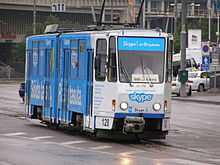Tatra KT4
| Tatra KT4 | |
|---|---|
 KT4D in Erfurt | |
| Manufacturer | ČKD Tatra |
| Constructed | 1977 - 1997 |
| Number built | 1747 |
| Specifications | |
| Articulations | 1 |
| Length | 18,100 mm (59 ft 5 in) |
| Width | 2,200 mm (7 ft 3 in) |
| Height | 3,100 mm (10 ft 2 in) |
| Weight | 19.9 tonnes (19.6 long tons; 21.9 short tons) |
| Passenger capacity seats | 26-38 (depends on model) |
| Passenger capacity standing | 105-168 (depends on model) |
| Maximum speed | 65 km/h (40 mph) |
| Doors | 4 |
| Engine power | 4 x 40 kW (54 hp) Motors |
| Bogies | 2 |
| Gauge | 1,435 mm (4 ft 8 1⁄2 in), 1,000 mm (3 ft 3 3⁄8 in), 1,524 mm (5 ft) |
Since the start of the 1990s many of the earliest production tramcars have gone through extensive refurbishment and rebuilding, including the replacement of folding doors and the installation of low floor center sections.
History
[1] The KT4 was originally designed to demands set out by the needs of the GDR, who found bogie cars too expensive and needed a solution to their aging fleet of two-axle vehicles. The first steps into the KT4s design were made when ČKD Tatra modified a six-axle K2 tramcar, to a four-axle suspended articulation formation which later presented itself in the KT4. The KT4 has identical pedal control systems and bogies as the Tatra T3 bogie tramcar. As production continued the design was improved, noted particularly in 1983 with the addition of thyristor control
Variations
Variations of the KT4 exist, though they are generally subtle and focused around seat layout and pantograph type.
- KT4D - German Model
- KT4SU - Soviet Union Model
- KT4YU - Yugoslavian Model
KT4D
The KT4D Model, was delivered to the following GDR cities;
| City | Delivery Years | Number Delivered |
|---|---|---|
| Berlin | 1976–1988 | 574 |
| Brandenburg | 1979–1983 | 16 |
| Cottbus | 1978–1990 | 65 |
| Erfurt | 1976–1990 | 156 |
| Frankfurt (Oder) | 1987–1990 | 34 |
| Gera | 1978–1990 | 60 |
| Görlitz | 1987–1990 | 11 |
| Gotha | 1981–1982 | 6 |
| Leipzig | 1976 | 8 |
| Potsdam | 1974–1987 | 45 |
| Plauen | 1976–1988 | 45 |
| Zwickau | 1987–1988 | 22 |
| TOTAL | 1974-1990 | 1042 |
In 1984 Leipzig handed over their 8 trams to Berlin. Since the early 2000s (decade) the Tatra tramcars in the former GDR are being replaced and sold to other countries in Central and Eastern Europe.
Original KT4D
-
.jpg)
KT4D Prototype in Potsdam
-

KT4D in Berlin
-
.jpg)
KT4D in Brandenburg/Havel
-

KT4D in Erfurt
-
%2C_Tatra_KT4.jpg)
KT4D in Frankfurt (Oder)
-

KT4D in Gera
-
.jpg)
KT4D in Gotha
-

KT4D in Görlitz
-
.jpg)
KT4D in Plauen
-
.jpg)
KT4D in Potsdam
-

at SRS Tramways
-

KT4D in Zwickau
Modernised KT4D
-

KT4Dm in Berlin
-
KT4Dm in Frankfurt/Oder
-

KT4Dm in Gera
-

KT4D mod 301 in Gotha 2005
-
both actual colors of KT4D in Görlitz
-

modernised KT4D in Plauen
-
KT4Dm double in Potsdam
-

KT4DC in Zwickau
-
KTNF6, rebuilt KT4Dm in Cottbus
-

KT4DC in Zwickau
sold KT4D
-

KT4D 82 in Galaţi, Romania former Berlin
-
KT4SU in Kaliningrad
-
KTNF6 in Cottbus
-
KT6T in Tallinn
KT4SU
The Soviet Union ordered the KT4SU for their meter gauge tramways, the following cities received deliveries;
| City | Delivery Years | Number Delivered |
|---|---|---|
| Yevpatoria | 1987–1990 | 18 |
| Kaliningrad | 1987–1990 | 30 |
| Liepāja | 1983–1988 | 22 |
| Lviv | 1976–1988 | 145 |
| Pyatigorsk | 1988–1990 | 25 |
| Zhytomyr | 1981–1988 | 20 |
| Tallinn | 1980–1988 | 74 |
| Vinnytsia | 1980–1990 | 81 |
| TOTAL | 1976-1990 | 415 |
KT4YU
The KT4YU, is the Yugoslav variant of the tramcar, these were delivered to the now Serbian and Croatian capitals. The last KT4s ever produced were delivered to Belgrade in 1997, these tramcars were equipped with IGBT-modules and named KT4M-YUB (where B stands for Belgrade to be distinguished from Zagreb model). In 2002. 30 Belgrade tramcars were modernized in Goša / Inekon, and marked as KT4-YUBM.
| City | Delivery Years | Number Delivered |
|---|---|---|
| Belgrade | 1980–1997 | 220 |
| Zagreb | 1985–1986 | 51 |
| TOTAL | 1980-1997 | 271 |
-

Tatra KT4M-YU (1997) in Belgrade
-

Tatras KT4 in Belgrade
-
.jpg)
KT4-YUB in Belgrade
-

KT4YUBM in Belgrade
-

Tatra KT4M-YU (1997) in Belgrade
-

Tatra KT4-YU in Belgrade
-

Tatra KT4-YU in Belgrade
-
.jpg)
Tatra KT4M-YU (1997) in Belgrade
-

KT4YUBM in Belgrade
-

KT4YU in Belgrade
-

Tatra KT4YU in Zagreb
-
.jpg)
Tatra KT4YU in Zagreb
-

Tatra KT4YU in Zagreb
Other variations of the KT4
A series of KT4 trams were also produced for Pyongyang, North Korea, but have subsequently had their articulation removed.
See also
Further reading
- (German) Ivo Köhler: KT4 - Der Kurzgelenkwagen aus Prag, Verlag GVE, Berlin 2009, ISBN 978-3-89218-104-0
References
- ↑ Source: The Development of The Modern Tram, by Brian Patton
Statistical Data, is duplicated from TatraWagen.de (In German)
| |||||||||||
| Wikimedia Commons has media related to Tatra KT4. |









